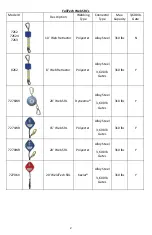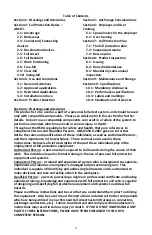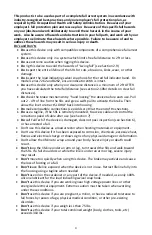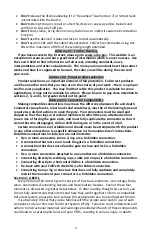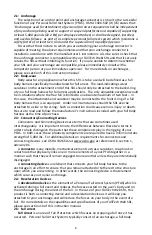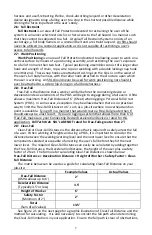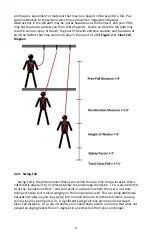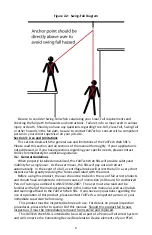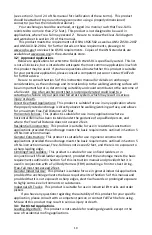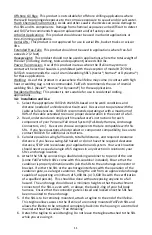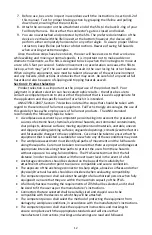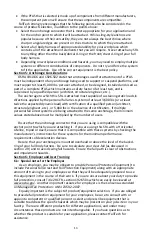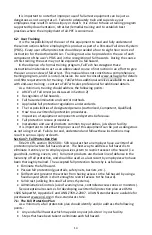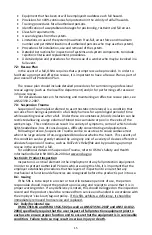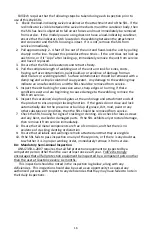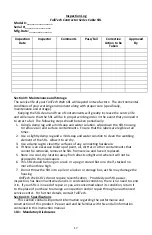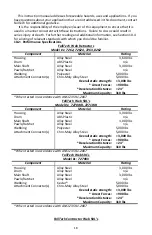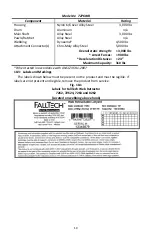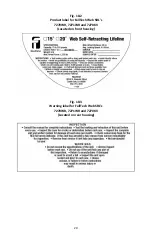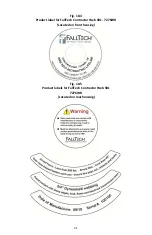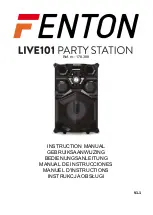
6
2.1:
Anchorage
The
selection
of
an
anchor
point
and
anchorage
connector
is
critical
to
the
successful
function
of
any
Personal
Fall
Arrest
System
(PFAS).
OSHA
1926.502
(d)
(15)
states
that:
“Anchorages
used
for
attachment
of
personal
fall
arrest
equipment
shall
be
independent
of
any
anchorage
being
used
to
support
or
suspend
platforms
and
capable
of
supporting
at
least
5,000
pounds
(22.2
kN)
per
employee
attached,
or
shall
be
designed,
installed,
and
used
as
follows:
as
part
of
a
complete
personal
fall
arrest
system
which
maintains
a
safety
factor
of
at
least
two;
and
under
the
supervision
of
a
qualified
person.”
Ensure
that
the
structure
to
which
you
are
attaching
your
anchorage
connector
is
capable
of
meeting
the
above
requirements
and
that
your
anchorage
connector
is
installed
in
accordance
with
the
manufacturer’s
instructions.
Also
be
sure
to
check
that
the
anchorage
connector
is
compatible
with
your
FallTech
Webr
SRL
and
that
it
securely
retains
the
SRL
without
inhibiting
its
function.
If
you
are
unable
to
determine
whether
your
SRL
and
your
anchorage
are
compatible,
please
immediately
consult
with
a
competent
person
or
your
immediate
supervisor.
For
more
details
on
anchorages,
please
see
section
5
of
this
instruction
manual.
2.2:
Body
‐
wear
Body
wear
for
any
application
where
this
SRL
is
to
be
used
will
be
defined
as
a
full
body
harness
specifically
manufactured
for
fall
arrest.
The
load
‐
indicating
swivel
carabiner
on
the
attachment
end
of
this
SRL
should
only
be
attached
to
the
back
d
‐
ring
of
your
full
body
harness
for
fall
arrest
applications.
The
only
allowable
exception
would
be
in
situations
where
the
free
fall
is
limited
to
an
absolute
maximum
of
two
feet
–
in
this
case,
the
attachment
‐
end
carabiner
may
be
connected
to
the
front
d
‐
ring
of
a
full
body
harness
that
is
so
equipped.
Under
no
circumstances
should
the
SRL
ever
be
attached
to
a
side
or
hip
d
‐
ring:
Such
a
connection
could
cause
serious
injury
or
death.
Be
sure
to
read
and
follow
the
manufacturer’s
instructions
included
with
your
full
body
harness
at
the
time
of
purchase.
2.3:
Connectors/Connecting
Devices
Connectors
and
Connecting
Devices
are
terms
that
are
sometimes
used
interchangeably.
It
is
important
to
note
the
differences
between
these
two
terms
in
order
to
help
distinguish
the
parts
that
these
components
play
in
the
rigging
of
your
PFAS.
In
both
cases,
these
products/components
are
required
to
have
a
minimum
static
strength
of
5,000
lbs.
For
additional
details
on
requirements
for
connectors
and
connecting
devices,
see
OSHA
1926.502
at
www.osha.gov
as
referenced
in
section
1,
advisory
#1.
A
connector
is
any
metallic,
mechanical
element
such
as
a
carabiner,
snap
hook
or
rebar
hook
that
physically
links
one
or
more
elements
of
a
your
PFAS
together
in
a
manner
such
that
they
will
remain
engaged
to
one
another
unless
they
are
intentionally
disengaged.
A
connecting
device
is
an
element
that
connects
your
full
body
harness
to
the
anchorage
in
an
effort
to
ensure
that
you
remain
attached
or
tethered
to
the
structure
upon
which
you
are
working.
In
other
words,
the
connecting
device
is
that
element
which
secures
you
to
your
anchorage.
2.4:
Deceleration
Devices
A
deceleration
device
is
the
element
of
a
Personal
Fall
Arrest
System
(PFAS)
which
is
activated
during
a
fall
event
and
reduces
the
forces
exerted
on
the
user’s
body
and
on
the
anchorage
during
the
arrest
of
the
fall.
In
the
case
of
your
FallTech
Web
SRL,
this
product
is
both
a
connecting
device
and
a
deceleration
device
as
it
will
keep
you
attached
to
your
anchorage
and
will
reduce
the
forces
on
your
body
in
the
event
of
a
fall.
For
more
details
on
the
capabilities
and
specifications
of
your
FallTech
Web
SRL,
please
see
section
10
of
this
instruction
manual.
2.5:
Fall
Arrest
Fall
Arrest
is
an
area
of
Fall
Protection
which
focuses
on
stopping
a
fall
once
it
has
occurred.
Personal
Fall
Arrest
Systems
typically
consist
of
an
anchorage,
a
full
body


